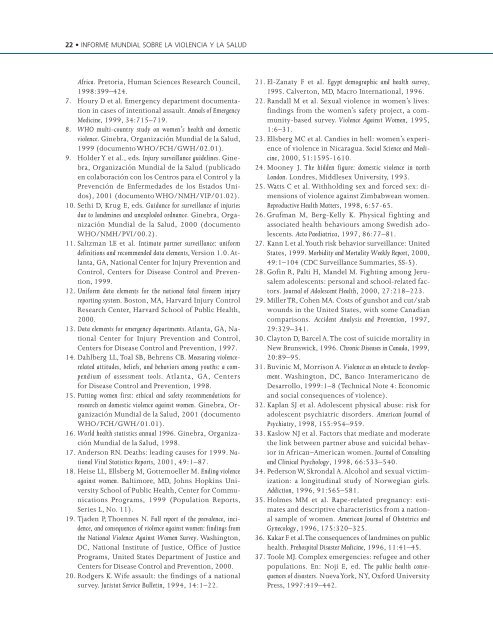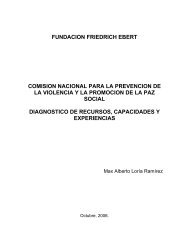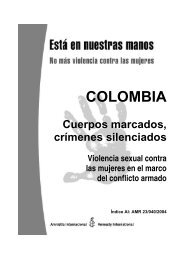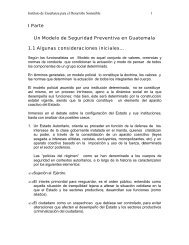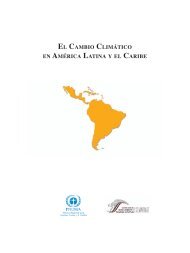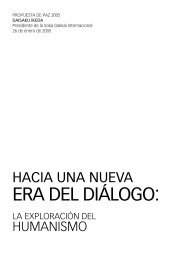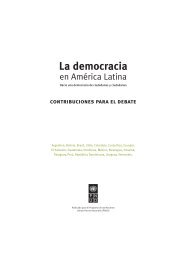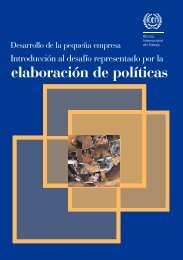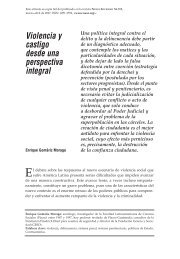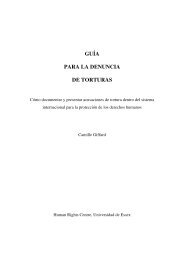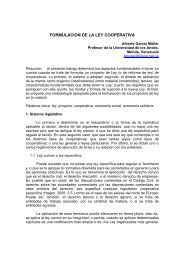Capítulo 1. La violencia, un problema mundial de ... - libdoc.who.int
Capítulo 1. La violencia, un problema mundial de ... - libdoc.who.int
Capítulo 1. La violencia, un problema mundial de ... - libdoc.who.int
You also want an ePaper? Increase the reach of your titles
YUMPU automatically turns print PDFs into web optimized ePapers that Google loves.
22 • INFORME MUNDIAL SOBRE LA VIOLENCIA Y LA SALUDAfrica. Pretoria, Human Sciences Research Co<strong>un</strong>cil,1998:399–424.7. Houry D et al. Emergency <strong>de</strong>partment documentationin cases of <strong>int</strong>entional assault. Annals of EmergencyMedicine, 1999, 34:715–719.8. WHO multi-co<strong>un</strong>try study on women’s health and domesticviolence. Ginebra, Organización M<strong>un</strong>dial <strong>de</strong> la Salud,1999 (documento WHO/FCH/GWH/02.01).9. Hol<strong>de</strong>r Y et al., eds. Injury surveillance gui<strong>de</strong>lines. Ginebra,Organización M<strong>un</strong>dial <strong>de</strong> la Salud (publicadoen colaboración con los Centros para el Control y laPrevención <strong>de</strong> Enfermeda<strong>de</strong>s <strong>de</strong> los Estados Unidos),2001 (documento WHO/NMH/VIP/0<strong>1.</strong>02).10. Sethi D, Krug E, eds. Guidance for surveillance of injuriesdue to landmines and <strong>un</strong>explo<strong>de</strong>d ordnance. Ginebra, OrganizaciónM<strong>un</strong>dial <strong>de</strong> la Salud, 2000 (documentoWHO/NMH/PVI/00.2).1<strong>1.</strong> Saltzman LE et al. Intimate partner surveillance: <strong>un</strong>iform<strong>de</strong>finitions and recommen<strong>de</strong>d data elements, Version <strong>1.</strong>0. Atlanta,GA, National Center for Injury Prevention andControl, Centers for Disease Control and Prevention,1999.12. Uniform data elements for the national fatal firearm injuryreporting system. Boston, MA, Harvard Injury ControlResearch Center, Harvard School of Public Health,2000.13. Data elements for emergency <strong>de</strong>partments. Atlanta, GA, NationalCenter for Injury Prevention and Control,Centers for Disease Control and Prevention, 1997.14. Dahlberg LL, Toal SB, Behrens CB. Measuring violencerelatedattitu<strong>de</strong>s, beliefs, and behaviors among youths: a compendiumof assessment tools. Atlanta, GA, Centersfor Disease Control and Prevention, 1998.15. Putting women first: ethical and safety recommendations forresearch on domestic violence against women. Ginebra, OrganizaciónM<strong>un</strong>dial <strong>de</strong> la Salud, 2001 (documentoWHO/FCH/GWH/0<strong>1.</strong>01).16. World health statistics annual 1996. Ginebra, OrganizaciónM<strong>un</strong>dial <strong>de</strong> la Salud, 1998.17. An<strong>de</strong>rson RN. Deaths: leading causes for 1999. NationalVital Statistics Reports, 2001, 49:1–87.18. Heise LL, Ellsberg M, Gottemoeller M. Ending violenceagainst women. Baltimore, MD, Johns Hopkins UniversitySchool of Public Health, Center for Comm<strong>un</strong>icationsPrograms, 1999 (Population Reports,Series L, No. 11).19. Tja<strong>de</strong>n P, Thoennes N. Full report of the prevalence, inci<strong>de</strong>nce,and consequences of violence against women: findings fromthe National Violence Against Women Survey. Washington,DC, National Institute of Justice, Office of JusticePrograms, United States Department of Justice andCenters for Disease Control and Prevention, 2000.20. Rodgers K. Wife assault: the findings of a nationalsurvey. Juristat Service Bulletin, 1994, 14:1–22.2<strong>1.</strong> El-Zanaty F et al. Egypt <strong>de</strong>mographic and health survey,1995. Calverton, MD, Macro International, 1996.22. Randall M et al. Sexual violence in women’s lives:findings from the women’s safety project, a comm<strong>un</strong>ity-basedsurvey. Violence Against Women, 1995,1:6–3<strong>1.</strong>23. Ellsberg MC et al. Candies in hell: women’s experienceof violence in Nicaragua. Social Science and Medicine,2000, 51:1595-1610.24. Mooney J. The hid<strong>de</strong>n figure: domestic violence in northLondon. Londres, Middlesex University, 1993.25. Watts C et al. Withholding sex and forced sex: dimensionsof violence against Zimbabwean women.Reproductive Health Matters, 1998, 6:57-65.26. Grufman M, Berg-Kelly K. Physical fighting andassociated health behaviours among Swedish adolescents.Acta Paediatrica, 1997, 86:77–8<strong>1.</strong>27. Kann L et al. Youth risk behavior surveillance: UnitedStates, 1999. Morbidity and Mortality Weekly Report, 2000,49:1–104 (CDC Surveillance Summaries, SS-5).28. Gofin R, Palti H, Man<strong>de</strong>l M. Fighting among Jerusalemadolescents: personal and school-related factors.Journal of Adolescent Health, 2000, 27:218–223.29. Miller TR, Cohen MA. Costs of g<strong>un</strong>shot and cut/stabwo<strong>un</strong>ds in the United States, with some Canadiancomparisons. Acci<strong>de</strong>nt Analysis and Prevention, 1997,29:329–34<strong>1.</strong>30. Clayton D, Barcel A. The cost of suici<strong>de</strong> mortality inNew Br<strong>un</strong>swick, 1996. Chronic Diseases in Canada, 1999,20:89–95.3<strong>1.</strong> Buvinic M, Morrison A. Violence as an obstacle to <strong>de</strong>velopment.Washington, DC, Banco Interamericano <strong>de</strong>Desarrollo, 1999:1–8 (Technical Note 4: Economicand social consequences of violence).32. Kaplan SJ et al. Adolescent physical abuse: risk foradolescent psychiatric disor<strong>de</strong>rs. American Journal ofPsychiatry, 1998, 155:954–959.33. Kaslow NJ et al. Factors that mediate and mo<strong>de</strong>ratethe link between partner abuse and suicidal behaviorin African–American women. Journal of Consultingand Clinical Psychology, 1998, 66:533–540.34. Pe<strong>de</strong>rson W, Skrondal A. Alcohol and sexual victimization:a longitudinal study of Norwegian girls.Addiction, 1996, 91:565–58<strong>1.</strong>35. Holmes MM et al. Rape-related pregnancy: estimatesand <strong>de</strong>scriptive characteristics from a nationalsample of women. American Journal of Obstetrics andGynecology, 1996, 175:320–325.36. Kakar F et al. The consequences of landmines on publichealth. Prehospital Disaster Medicine, 1996, 11:41–45.37. Toole MJ. Complex emergencies: refugee and otherpopulations. En: Noji E, ed. The public health consequencesof disasters. Nueva York, NY, Oxford UniversityPress, 1997:419–442.


